Part One: The History and Culture of Poland by Judith Zielinski-Zak
Polish Cultural Development and Contributions
Courageous, proud and daring, the Poles are like the eagle that has served as their national emblem since the twelfth century. They have preserved their culture and national identity against the nearly insurmountable odds of debilitating alien rule, devastating major wars and the surrender of their lands for 150 years to foreign powers. The Poles’ intense pride in their culture is more than justifiable considering the broad spectrum of human endeavor they have enriched through their contributions.
In the eighteenth century, Poland was systematically erased as a viable political nation. Nothing was left except a cultural bond which was the glue that bonded together a modern Poland, more vital than ever. Polish culture is more than a collection of modes of expression in the arts or folkways. It is a symbol of life and the self-expression of a nation which refused to die. An excellent place to search for clues into this national character is Polish literature which both reflected and influenced the life of the nation. Literature became a vehicle for dramatic change. The realistic novel achieved greatness, poetry found new purpose and short stories developed into cut diamonds of literary perfection.
Literature
The first literature produced in Poland was of a religious nature and was influenced by Western Roman Catholicism. Nearly all of this literature was in Latin, not Polish. Those who could write and read were usually members of the clergy. The higher officials of the Church were often well educated members of the wealthy gentry class residing in the large cities. Most of the parish priests living in rural areas could neither read nor write, and in the early centuries of Catholicism, would often memorize the liturgy of the mass and other prayers.
Not until the sixteenth century did a country gentleman, Mikolaj Rej (1505-1569) begin to write in the Polish language. Named the “Father of the Polish Language,” Rej wrote both poetry and prose which was satiric, earthy and humorous. He wrote in the vernacular for his contemporaries. Unfortunately little of his work is translated, or even translatable due to its very nature.
The most famous exponent of the Renaissance in Polish literary life is Jan Kochanowski (1530-1584). His education at Padua (Italy) and Krakow, along with his travels in France and other countries exposed him to a wide variety of cultures during this exciting period. His works reveal his humanistic bent and his great knowledge of Latin and Greek literature. He mastered nearly every genre in literature and became known as the greatest poet of the Slavic world, and the “Father of Polish Literature.”
Three poets are considered by most experts to be the greatest in the history of Polish literature: Adam Mickiewicz (1798-1855), Juliusz Slowacki (1809-1849), and Zygmunt Krasinski (1812-1859). Adam Mickiewicz is the national poet of Poland and her chief Romantic writer. His major work Pan Tadeusz (available in two English translations) is Poland’s national epic set in the period of the Napoleonic wars. It has no equal in Polish literary history. But it was the publication of his Ballads in 1822 which is said to be the true beginning of Romanticism in Poland. Mickiewicz emigrated to France in 1830 and later became involved in the activities of the 1848 revolutions in Western Europe. He taught Slavic literature at the College of France in Paris, and his writing turned patriotic in nature. He continued his teaching until he became immersed in mysticism. After his retirement, he participated directly in military resistance against Poland’s captors until his death in 1855.
Juliusz Slowacki was also a Romantic poet and he, too, wandered over Europe. Like Mickiewicz, he was a fiery patriot; only his death prevented him from participating in a revolt in Poznan. He wrote drama, poetry and tragedy with a flair for historical elements and mysticism. His epic poem Beniowski, has been compared to Byron’s Don Juan. Though many parallels can be drawn between the lives and works of Slowacki and Byron, the former was clearly writing in a Polish style of his own creation and themes. Other works include his great King Spirit which he was finishing when he died.
It is interesting to note that Mickiewicz considered Slowacki a minor, not very distinguished rival and something of an upstart as well. Slowacki continually felt humiliated, and in his poetry may be found a few subtle unflattering references to Mickiewicz. Today the two great poets lie side by side in Wawel Cathedral in Cracow, together and at peace.
Zygmunt Krasinski is the third member of this trio of Poland’s greatest writers. Also a Romanticist, he was at his best in the two works, Undivine Comedy and Irydion.
In the nineteenth century the most popular genre was that of the novel. During this time, despite the Partitions, the Polish novel flourished. Joseph I. Kraszewski (1812–1887) produced an incredible volume of work of uneven quality. His more than six hundred works included not only novels, but also poems, essays, plays, biography and history. One particularly interesting work is his novel Hrabina Cosel (Countess Cosel), a historical work renowned for its detail and its powerful story of a noblewoman set against the background of seventeenth century court life. A few years ago, the Polish film industry made this novel into a remarkably authentic film. Another work, The Jew (translated into English in 1890), is a sensitive portrayal of the relationships between the Poles and the Jews in nineteenth century Poland.
Boleslaw Prus (1845-1912) wrote many short stories but is best known for his novel The Pharoah, set in ancient Egypt, and his fascinating novel, The Doll. The latter not only explores social attitudes and class morality in that era but is an intriguing character study of a man whose love for a woman “above his station” drives him to the depths of anguish. This book is available in English and has been made into a movie by a Polish film company. Polish films of this nature are often shown in cities with large Polish populations in America. Because of their historical nature and the excellence of production, they are never out of date.
Although there were several outstanding women writers in Poland, the most interesting is Eliza Orzeszkowa (1841-1910), whose work reflects concern for her homeland, modern vision, and patriotism. Her most famous novel, Marta, explores the woman of the nineteenth century. Marta, widowed and alone, must seek livelihood for herself and her daughter. Society set narrow parameters in which she could earn a respectable living; consequently, Marta is faced with a series of disappointments and tribulations. Translated into many languages, this novel was used as a battlecry for the equality of women.
Much of Orzeszkowa’s work remains untranslated. Her short stories deal with a variety of themes, but those with a Jewish motif are remarkable for their sensitivity and indicate a brave undertaking on the part of the author. Orzeszkowa fought against ignorance and superstition, convinced that fact and compassion could dispel many social problems of her day.
The Polish writers best known to American readers are Henryk Sienkiewicz (1846-1916), Wladyslaw Stanislaw Reymont (1867-1925) and Joseph Conrad (Teodor Korzeniowski, 1857-1924). Sienkiewicz traveled widely, and his Letters From America reveal much about our own country. His Trilogy of historical novels, set in the seventeenth century, look to the past glory of Poland. English readers are most familiar with Quo Vadis, a novel which won the Nobel Prize in 1905.
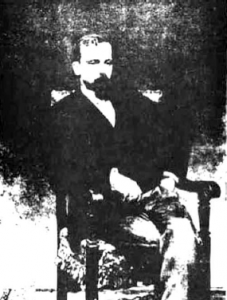
One of the most popular writers of narrative. Received the Nobel Prize in 1905. His most important works: Quo Vadis, Ogniem i mieczem (With Fire and Sword), Potop (The Deluge), Krzyzacy (The Knights of the Cross), Pan Wołodyjowski (Pan Michael), W pustyni i puszczy (In Desert and Wilderness). He toured the United States and was present at the Philadelphia Centennial Exposition in 1876. (This picture taken from the collection of pictures entitled Great Poles by Edward Fracki, Stanislaw Brodzki and Andrzej Zahorski. Warsaw: Interpress Publishers, 1970.)
Reymont’s The Peasants, also translated into English, won the Nobel Prize in 1924. No one has surpassed Reymont in his portrayal of the peasantry and the novel with its lifelike characters is extremely readable.
Joseph Conrad wrote his best work as an exile and in English, a foreign language to him. He fought for social justice, and he used psychological interpretations in character portrayal. Because Conrad had been a seafaring man for much of his life, he set his novels against exotic backgrounds and the sea. Critics often consider the novel Heart of Darkness his best literary creation, but Lord Jim (of which an excellent film was made) and The Nigger of the Narcissus are better known to the reading public.
Modern Polish writers of renown are numerous and include Julian Tuwin (1894-1953), whose poetry of the interwar period is outstanding; Witold Gombrowicz (1904-1969), whose novels were controversial; and Slawomir Mrozek (1930- ), who is most famous for his play Tango produced throughout the world.
Music and Dance
Native Polish music began even before Christianity was officially established in 966. Simple music was sung and crude instruments used. After the tenth century, religious music dominated. The most famous hymn still sung today is Bogarodzica, a hymn to the Mother of God, Poland’s special protectress. Later, court life in Krakow and the influence of the Renaissance brought secular music to prominence. The impact of this cultural flow was enormous. Other countries began to imitate a style of Polish music, characterized by fast and slow movements. This led to the universally known polonaise which originated as a peasant dance, and came to be performed in courts throughout Europe, even before Chopin’s time.
It is interesting to note that, while Italy gave birth to the opera, Poland was the second country in which opera began to be performed regularly. The first professional theater was opened in 1765, one of the projects of the last king, who promoted culture extensively. The first opera, thoroughly Polish in music and theme, was Cud Mniemany, Czyli Krakowiacy i Gorale (The Supposed Miracle of the Cracovians and the Highlanders). It is still performed today.
Polish folk dances contain elements of many cultures. Interaction historically with Czechs, Russians, Germans, Swedes, Bohemians, Ukrainians and Turks has produced a rich variety of uniquely Polish dances, such as the kujawiak, krakowiak and oberek. Americans tend to associate the polka with true Polish culture, but those who visit Poland never see the polka performed. The association of the polka with Poland is partly due to the close word resemblance (a Polka means a female Pole in the Polish language) and the mutation of the above native dances, upon their transplantation to American soil.
Two state-sponsored dance troupes are the Mazowsze and Slask who perform all over the world. Some American groups have kept the native dances alive as well, in particular, the renowned Kujawiaki Dancers of Alliance College in Cambridge Springs, Pennsylvania. Under the director Jan Sejda, this group has reached great levels of achievement in Polish choreography and costume. They have performed throughout the United States and abroad.
Christmas carols, too, are among the most beautiful and varied of the world’s sacred music. They include the hauntingly lovely lullaby to the Infant Jesus, “Lulajze Jezuniu” which dates from the seventeenth century.
Fredryk Chopin (1810-1849) is the most beloved of Polish composers, though many people still think he was French. Indeed his father was French, but Chopin was born in Poland. His home is now a national shrine. He used the themes and rhythms of his native land making them part of the world’s musical heritage.
Ignacy Jan Paderewski (1860-1941) known also as a statesman and patriot, gave the world much more than his “Minuet in G.” Many of his musical compositions such as the “Fantastique Cracovienne” reflect his ability to use and knowledge of traditional Polish themes. Paderewski played with gusto and great showmanship, making him a favorite pianist throughout the world.
Known as the “Father of Polish National Opera,” Stanislaw Moniuszko (1818-1872) produced the immortal Straszny Dwor (The Enchanted Court) in which the characters, from gentry to peasants, were genuinely Polish. Halka, another favorite, is still performed in our time.
Karol Szymanowski (1882-1937) was part of the group of artists in the period of “Young Poland” between the two World Wars. He too, turned to native themes in his exquisite ballet Harnasie (The Mountain Robber Chieftains). His music became part of universal musical heritage and is even more popular today since during his own time Szymanowski was regarded by his contemporaries as too avant-garde.
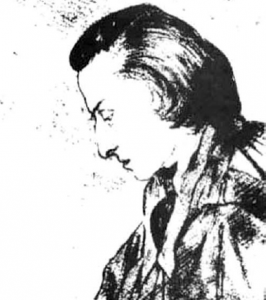
Drawn by George Sand
One of the greatest and most popular composers of all time. He made the themes and rhythms of his native land part of the world’s musical heritage.
Two modern and vital composers known for their creativity and originality are Witold Lutoslawski (1913- ) and Krzysztof Penderecki (1933- ).
Art
Polish art is varied and rich. Historians differ as to the periodization of the various stages through which Poland passed. It should be emphasized that Poland did experience, as did other European countries, the distinct eras of Romanesque, Gothic, Renaissance, Baroque, Rococo, Impressionism and Modern art and architecture. These periods never have sharp edges in any country; they melt, blur and shade into each other.
Nineteenth century painting, the age of the representative artist, endures as a testament to the vitality of Polish culture. It reflected every facet of Polish life. While the architecture of the early periods was influenced by Western concepts, especially in the construction of churches and palaces, painting developed from the religious “board painting” of the thirteenth century and evolved to the glory of nineteenth century masters who were highly individualistic and secular in their outlook.
Jan Matejko (1838-1893) was Poland’s greatest national historical painter. Familiar with history and archeological studies, Matejko decided to portray the honor and glory of the past in massive canvases such as “The Battle of Grunwald.” Every detail of costume and background was assiduously and correctly portrayed by the master and his students. Matejko’s art had more than one purpose. He wanted to show the Poles their own bright history in the dark days of the Partitions. Visitors to the Vatican Museum are often surprised to view the large canvas by Matejko which was presented as a gift to the Pope.
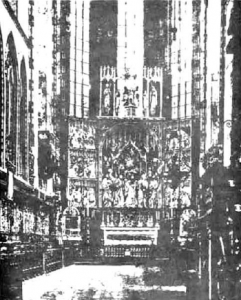
Stanislaw Wyspianski (1869-1907) was a poet and dramatist as well as a great painter. Though a student of Matejko, Wyspianski developed his own distinct style, influenced by French Impressionism. With deft artistic alchemy, he changed that influence into Polish themes. His portraits are rich in color and expression and he often painted members of his own family. His stained glass windows are truly ingenious and amazingly “modern” for the period in which they were created.
During the twentieth century, in an independent Poland, a great deal of activity took place in the pursuit of the arts and continued until World War II. In approximately 1948, the style of Socialist Realism was introduced through Soviet influence, especially in the realm of architecture and in the sculpture of massive monuments. An example of this is the Palace of Culture in Warsaw which is huge and box-like. Since 1955, however, a renaissance of art has taken place from music to drama, and the Polish poster art form has come to be recognized as one of the greatest of its type in the world.
It is a tribute to the Polish people that much of their art has been preserved or reconstructed. During the holocaust of World War II much was destroyed, some deliberately when, for example, the Nazi army systematically mined and destroyed Stare Miasto, or Old Town in Warsaw. After the war, Old Town was painstakingly recreated to a nearly perfect replica of its former beauty. The Lazienki Palace, home of the last king, is a jewel of classical eighteenth century design and also has been reconstructed. Visitors to the palace may visit an exhibit of the damage inflicted upon the building; after viewing this, the restoration seems a veritable miracle. Wilanow, just outside Warsaw, and the home of King Jan Sobieski, was also painstakingly refurbished. Its parks and gardens are meticulously manicured, and its art collection is truly astounding. These are only two examples out of hundreds.
These projects represent much more than the efforts of official government agencies. They were achieved by the labor of all the people, cutting across all class lines. From the eminent art historians and architectural geniuses to the lowliest farmers, the people literally wrested their heritage back from oblivion.
One famous example of such dedication is the work of noted scholar and art historian Karol Estreicher of the Jagiellonian University. He and his colleagues managed to trace the famous Wit Stwosz altar which the Nazi army had hidden in Nuremberg. It was found and returned to Krakow and is a glorious sight, restored to its original place in St. Mary’s Church.
Poles exhibit a reverence, quiet respect and interest in their frequent visits to their own historical sites. When a Pole visits Old Town, for instance, he knows the price which was paid for its reconstruction. That price to him is more than zloty (the Polish monetary unit). It was paid with untold labor and patriotism and a sacrifice in the production of consumer goods and housing.
Science
To record Polish achievements in the sciences would require far more space than this volume offers. Therefore, in science we shall focus upon just a few contributors. Mikolaj Kopernik (1473-1543) literally established the bases for modern astronomy. Known by his Latin name of Copernicus, he revolutionized the study of the universe by his work “De revolutionibus orbium coelestium” printed in 1543, the year of his death. Copernicus asserted the theory that the sun was the center of the universe and that the earth rotated on its axis, revolving about the sun. For centuries mankind thought that the earth was the center of the solar system.
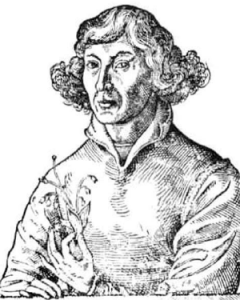
One of the most brilliant minds of the European Renaissance. (This picture taken from the collection of pictures entitled Great Poles by Edward Fracki, Stanislaw Brodzki and Andrzej Zahorski. Warsaw: Interpress Publishers, 1970.)
At first few people accepted Copernicus’ ideas. His theory could not be proved until Galileo invented the telescope. There was also much opposition from the Church which regarded the new theory as dangerous to some aspects of theology.
Copernicus should be remembered, too, as an outstanding doctor of ecclesiastical law, and an expert in medicine, economics and trade. Recently the world has celebrated the 500th anniversary of his birth, and much new literature is now available concerning this genius, a true “Renaissance man.”
Maria Sklodowska-Curie (1867-1934), known as Madame Curie, is often mistaken for a Frenchwoman because her married name is French. She was an outstanding chemist and physicist who collaborated in Paris with her husband in projects which resulted in the discovery of the radioactive element, radium. She received two Nobel prizes for her work, in 1903 and 1911. There are many excellent biographies of her in English as well as French and Polish.
Another famous scientist of Polish origin is Kazimierz Funk (1884-1967) who revolutionized the study of nutrition in medicine in his work with “vitamins” as he named the substances he explored. Tadeusz Krwawicz (1910- ) developed new techniques in eye surgery and is well known in the world of medicine. His technique is used extensively, especially benefiting members of the older generation who suffer from cataracts which form on the eye and cause loss of vision. This Pole developed cryosurgery, or the frozen method of dealing with a delicate surgical problem, as the best possible low risk method.
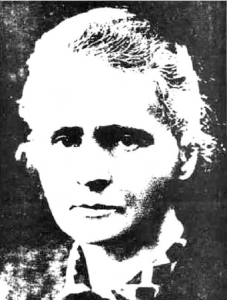
Co-Recipient of 1903 Nobel Prize for Physics
Awarded 1911 Nobel Prize for Chemistry
(This picture taken from the collection of pictures entitled Great Poles by Edward Fracki, Stanislaw Brodzki and Andrzej Zahorski. Warsaw: Interpress Publishers, 1970.)
Customs
Those who visit Poland for the first time invariably cite hospitality as a national characteristic, and indeed it is, with centuries of tradition behind it. In olden times, with few roads and impassable areas in winter frosts and spring floods, Poland was the crossroads of many travelers and merchants. Each Polish home, whether wealthy or modest, became a refuge for the weary. There is an old Polish proverb which the Poles take literally: “If a guest is in the home, then God is in the home.” Over the years a custom called “kulig” (literally, a sleigh) developed. Especially during the holiday season in December, one manor house would host a party. Then all the guests would merrily pile into sleighs lighted by torchlight and dash off through the crisp shimmering snow to the next manor, and so on, with great laughter and gaiety. Refreshments would include a steaming mug of hot honey wine, or miod pitny, bigos, or Hunter’s stew, and great slabs of fresh rye bread.
Societies hold up for emulation persons they revere and respect by setting aside days of celebration in their honor. It is in this manner that a society shows its children what virtues to imitate and what events it considers significant. For the Polish and also Polish Americans, Christmas and Easter are two such events. Indeed, it is in the celebration of these events that one finds the origin of drama in Europe. Thus it is with jaselko in Poland.
Jaselko in Polish has two meanings: (1) crib or manger and (2) Christmas play. The custom of recreating the Christmas scene was introduced into the countries of Europe by traveling monks and was greeted enthusiastically in an age when education could not depend upon universal skills of reading and writing.
In the beginning, the jaselko, or nativity scene, was a roofed, three-sided portable scene containing figures depicting various events such as Mary and Joseph seeking a lodging, the Nativity, the adoration of the shepherds, and visit of the Three Kings. The jaselko was displayed from Christmas until Candlemas Day, February second. Later puppets, then monks, and actors replaced the wax or wooden figures and dialogue was added. With such additions, theater was born. Centuries later, this was the only theater many rural people were ever to see.
As students and village laymen participated more, the drama became more secular and took on a flavor characteristic of the locale. For example, the Latin text and Bethlehem location were soon replaced with a Polish one. Moreover, scenes and characters (e.g. Herod, the devil and death) that reflected current concerns were added until by the 18th century the entire scene was the picture of Polish life as it was then lived: for example, the Three Kings were shown with their cavalry and infantry and pitched tents. Sometimes the Kings were from Polish history like Sobieski.
Sometimes death and the devil would dance together or fight. As the tone of the interludes became more humorous and the behavior of the crowd more indecorous, the Church was forced to return to immovable figures, thus leaving the szopka (as the jaselko was then called), that is, the puppet show or live show, entirely in the hands of lay people, often brought from home to home.
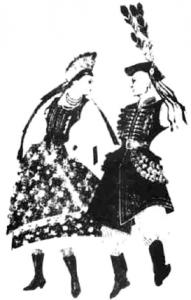
In Krakow the szopka became a grand affair of two stories with winged towers adorned with clocks. Later there were three stories with different scenes displayed in different parts.
In December of 1967 it was reported that these Christmas puppet shows were still occurring in the villages near Babka. Indeed, a Krakow museum arranged a competition for them. The group that won the prize included characters such as the picture peddler, the traveling medicine man, the nobles, the hussar, and the gypsy with a bear. Another group presented a show with dialogue that was described as “permeated with a sharp satire against the many undesirable manifestations of contemporary life.
Thus the celebration of Christmas has given rise to the szopka, which is preserved by many throughout the world who place a crib beneath their Christmas tree and which as a puppet show is still a custom in villages of Poland today. It is also an example of changing customs for it both preserves the past and adjusts to the present as it has become a theatrical vehicle for a commentary on contemporary life.
Easter Monday, known as “Smegus” or “Dyngus,” is a gay day for all, especially for young people. The boys douse the girls with water; those of more “genteel manner” do the dousing with perfume or cologne. The girls avenge themselves on Tuesday.
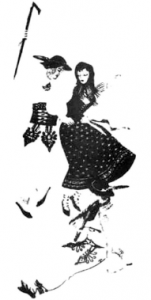
Religious Holidays
Much of Old World Polish culture revolved around Roman Catholicism. However, it retained remnants of paganism, a phenomenon common in East Central Europe, the Balkans, Russia, and other parts of the world.
Poland’s feast of St. Barbara, the Barburka, celebrated December 2 is quite unique. This saint is the patron of miners; mining is one of the oldest Polish industries. In the famous Wieliczka salt mines not far from Krakow in operation for more than one thousand years, a mass is celebrated in an underground chapel carved of salt. Students at mining academies consider this a special night and the student clubs are crowded with students dressed in their Sunday best to celebrate the Saint’s feastday.
St. Nicholas Day, December 6, is celebrated throughout much of Europe. In Poland, small gifts are exchanged among family and friends in honor of the saint.
The most sacred holiday is Wigilia, or Christmas Eve, when the first star appears in the evening sky. The family gathers at the table, often covered with white linen underneath which some bits of straw have been placed to commemorate the birth of Christ in a manger. Often one chair is left vacant in honor of the Christ Child. On the table is oplatek, a very thin unleavened bread of flour and water, formed in beautiful designs. Poles and Americans exchange oplatek in small bits attached to Christmas cards to preserve a sense of social unity.
Since it is a fast day, such foods as clear beet soup, herring, cabbage, mushrooms, carp and small cakes are served. Later there is wine and toasting, to accompany the exchange of presents. After supper, the family gathers at the decorated Christmas tree and sings carols together. Afterwards, many people attend midnight mass, known as the “shepherds’ mass.”
The Lenten and Easter seasons are permeated with medieval customs. One of the most beautiful, and one which thrives in America today, is the Swieconka, or the blessing of Easter baskets on Holy Saturday. These baskets usually contain ham, bread, sausage, salt, pepper, eggs, and butter formed in the shape of a lamb as a symbol of Christ. Included also are vinegar and horseradish. All are covered by delicate gaily decorated linen cloths, and the food is regarded as truly holy, having been blessed in church by the priest. Therefore, it is only to be eaten on Easter Sunday and on the days following.
Eggs colored by being dipped in dyes after they have been prepared with wax designs are a Slavic custom. In Polish these eggs are called pisanki. They are exchanged as small tokens of affection at Eastertide. The art has been developed to its highest degree by the Ukrainians who are its masters. The Poles, too, create lovely work and also paint geometric designs on carved wooden eggs. An ancient Slavic saying predicts that as long as eggs are decorated at Easter, evil will not destroy the world; from time immemorial, eggs have been regarded as a symbol of life and rebirth.
One of the most interesting Slavic customs is the celebration of Sobotki or Midsummer Night’s Eve (St. John’s Eve). This is a perfect example of the intermingling of pagan and Christian customs.
On this, the longest day of the year, the pagans celebrated the sun god’s glory with displays of mighty flames. This was supposed to be a magical night. In modern times, though, much of the ancient meaning is treated with light humor and whimsy; young people in Poland still spend St. John’s Eve by playing games and building “magical fires.” Young girls can be seen casting wreaths of flowers on the waters of lakes and streams with lighted candles attached to them.
November 2, All Souls’ Day, in Poland will find that country one vast moving group of people on their way to visit the cemeteries. For on that special day the people believe no grave must be allowed to go unattended. In modern Krakow, for example, the city government has arranged that all public transportation move in an orderly manner to the largest cemetery. Ribbons are used as guides to walkways and the people silently move along carrying wreaths, flowers and candles, from dawn until dusk. At different points throughout the cemetery, priests and nuns mingle easily with police, soldiers and the common people in an atmosphere of reverence. Religious services are carried on in the chapel, with the loudspeakers enabling the crowds spilled out onto the lawns to listen and participate in the responses to the prayers. Banners, flags, flowers and candles surround the grave markers, including those gravestones of the soldiers from foreign lands. All Souls’ Day is a moving and profound expression of the faith of the Polish people and an indication of another national characteristic–the respect accorded to deceased relatives and friends.
Cuisine
Sceptics today may say there is no true style of Polish cooking, only a mixture of other nationalities. This is not so. There is a unique Polish cuisine with a long historical tradition. Of course, other countries have been influential, notably Italy and France. Alina Zeranska has recently published an excellent cookbook in English, The Art of Polish Cooking.
The mainstays in Polish diet reflect the country’s agricultural produce. Bigos is of very old derivation and is still a popular Polish dish composed of a variety of meats and cabbage, all simmered for a long period and prepared with a hearty dash of spices. There always was a contrast between the diet of the rich and the poor, but the basic foods have always been and remain: mushrooms, wild berries, crayfish, game birds, cabbage, potatoes, many varieties of fish, kasza or buckwheat, sour cream and other dairy products. Beet soup, or barszcz, and czarnina, which is duck blood soup are delicacies. The variety of soups is extensive, and distinctive Polish soups include many kinds of fruit soups, served chilled or piping hot.
Krakus ham is famous the world over, but today it is produced for export only. While Americans may purchase it in supermarkets, the Poles must purchase it with currency of the free world at their PEKAO or state stores.
Weddings
Many changes have taken place in modern Polish weddings in the cities, while country weddings, especially in the southern mountain regions, maintain more of a traditional character. Some of the peasant customs are coarse and lusty comparable to those of America’s Old West and the “shivaree” depicted in the musical Oklahoma. Because of urbanization and industrialization, peasant customs have disappeared from the cities.
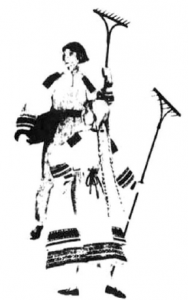
Two traditions, however, persist: the unveiling of the bride at the conclusion of the wedding celebration, called the “Oczepiny,” and the blessing of the bridal couple by the parents. In the former, a small cap is placed on the head of the bride, replacing the veil. This symbolizes that she has officially assumed the responsibilities and obligations of her new status. The latter is a blessing by the parents before the ceremony as the couple kneels before them, often including the sprinkling of holy water by the parents.
Today the law requires a civil marriage in Poland, and most young couples dutifully go through the civil ceremony. On the following day, the religious ceremony takes place in church. It is not uncommon to see the wedding parties rushing from automobiles to visit the photographer’s studio immediately after the service, just as is done in America. In the countryside, or na wsi, winter weddings are common. Set against the white landscape, they are celebrated in tiny very old churches. When the bride and groom emerge from the church, they hurry to a waiting sleigh and dash off, followed by their family and friends, to the reception at home.
In America during the early years of Polish-American ethnic communities, Polish weddings lasted as long as three days, and invited guests included whole neighborhoods. The newly married couple would often receive enough money to give them a healthy start in married life. But customs change and in recent times, many marriages have become quiet family affairs due to rising costs, the disintegration of the ethnic communities and the preference for small receptions immediately following the church service. Intermarriage between nationalities has also had the effect of decreasing interest in such traditions.
All customs which revolve around life, death and marriage were closely bound up with agrarian life and the church. As society in both America and Poland has become more industrialized and more secular, many practices have become extinct. However, many of the traditions associated with religious ritual still thrive in Poland and everywhere Polonia exists in the modern world today.
Historical Traditions
One unique practice which is neither specifically religious nor secular evolved in Krakow as a historical custom developed from a particular incident. It is that of the “Lajkonik” which is a man dressed in Tartar costume, part of which is a wooden horse strapped to his figure. Although the Lajkonik is part of the Corpus Christi or religious procession, he is actually a reminder of the thirteenth century invasions of the Tartars. They rode into Krakow in those days, plundering and murdering the population. The citizens of the city valiantly fought off the invader but the initial effect was devastating to the city. So popular is the Lajkonik tradition that the name has become a trade name for many products sold in Poland, including cosmetics and candies.
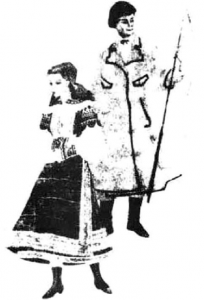
Stemming from the Tartar invasion is the legend so well described in the famous children’s book, The Trumpeter of Krakow.
High on one of the towers of St. Mary’s Church in the center of the town, facing the famous square with its Cloth Market, or Sukiennice, a young trumpeter saw the approaching Tartar army. Again and again he tried to warn the populace by sounding the melody of the Hejnal, a hymn to the Mother of God which was played four times in four directions every hour. This time, however, the people realized that the Hejnal had become a signal of danger. The Tartars swiftly galloped into Krakow as the people hastily prepared their defenses. A skillful Tartar bowman pierced the throat of the gallant trumpeter with an arrow.
Today the Hejnal is played every hour from the same tower and, if one watches closely when the sun is shining, the glint of the trumpet may be seen as the melody is played four times to the four winds. This practice has continued for centuries and the ringing notes break off poignantly and abruptly to commemorate the death of the brave trumpeter and the defenders of the city. Although a legend, a kernel of truth probably lies somewhere in the story.
Patron saints’ namedays are celebrated in Poland rather than birthdays. Nearly every Pole bears the name of a saint. This day is called Dzien Imieniny. While the person’s real birthday is often quietly celebrated by the immediate family, the nameday is a grand affair and the happy celebrant is surrounded by friends, relatives, presents, flowers and a special supper table. The traditional “Sto Lat” is sung. There is no precise translation, but the meaning is a wish that the honored guest should live a healthy life to the ripe old age of one hundred years. Red and white, the national colors of Poland, usually decorate the home and each guest will arrive bearing not only a gift, but a single red or white carnation. This charming practice results in a large vase filled with the colorful, fragrant flowers by the time the last guest arrives.
State Holidays
State holidays include International Women’s Day, March 8, the slogan of which is “A flower for every Eve.” In this way, no woman is forgotten. Special parties are held by student clubs which begin with everyone participating in the polonaise after which there are games, prizes and dancing. Other commemorative days include: Children’s Day, June 1; Independence Day, July 22; a day to honor youth, November 10; student’s day, November 17; railroad workers, September 11; and teachers, September 1. These holidays indicate the importance which the state places upon certain occupations as vital to society.
The first of May is the official “Labor Day” throughout the Communist world and no effort is spared to make the May Day parade in the large cities both of and for the people. Each labor group, many student groups, and members of various trades and military units participate, wearing specific symbols to identify their group.
They march in units headed by banners. The largest parade is held in Warsaw, the capital, and the marchers pass in review before stands filled with official state dignitaries who make speeches. Observers in the Western World pay special attention to May Day parades in all capitals of the Soviet bloc, since these manifestations in the form of parades and speeches often reveal the political situation of that particular year. For example, some years have seen a great show of military strength in the form of tanks and fighting units, while in other years the atmosphere has been more relaxed. Generally speaking, the parades are exciting and interesting and people clearly take part with more than average enthusiasm.
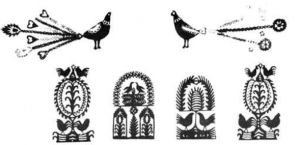
The Poles have never forgotten their famous, and stillborn, constitution of May 3, 1791. During the period of the partitions, since no celebrations were permitted, the people adopted instead a religious feast of Our Lady, Queen of the Crown of Poland, Trecziego Maja. This feast is observed by the Poles and by Polonia in the free world, though it is not officially recognized by the Polish government. In its place the government has set aside a series of days called “Days of Learning, Books and the Press” during which huge book fairs are held. People crowd the bookstalls, for the Polish people are great lovers of literature and bargains are everywhere. Even one of the main streets in Krakow is still called Trecziego Maja, despite the lack of official recognition of this special day in Polish history.
Polish history may be viewed as one of constant challenge and response. Far more than geography, the unique, self-defeating sociopolitical system that evolved invited the partitions and humiliation suffered by Poland. Her history, however, is not that of a martyr. The great dynasties of Piast and Jagiellon built and consolidated a great kingdom. But the transition to an elective monarchy took place during the very time when strong central leadership was needed to cope with the problems inherent in expansion.
Foreign wars, elected monarchs with little or no vested interest in Poland and the selfishness of the gentry strained the country. Reform came from within, but it came too late. The partitions did not destroy Poland. The Polish people remained united culturally during the difficult years of foreign domination. They rebuilt a modern state without benefit of experience in self-government. They survived two World Wars, and they live, today, a nation with a proud past and a hopeful future, even within the constraints of the Soviet bloc.
Legends
The Founding of Poland
It is believed that the Slavonic tribes originally lived in the area of what is Poland today but later moved out because the region was overpopulated. Those who stayed founded Poland. The name Poland comes from Poliane, which means “Lowlanders,” that is, those that live in the lowlands or fields. Another Polish group was called the Lechs, which is derived from the Old Slavonic word for forest–les –for the Lechs lived in the woo
One story of the founding of Poland involves three brothers, Lech, Czech, and Rus, who were forced to go off separately in search of fresh land for their flocks and more space for their great families. In order to select the best place, Lech climbed a tree and told his brothers what he saw. When he described the land to the east as a fertile land near a river, the brother named Rus set off for it. Today this is called Russia. To the south he saw mountains that would provide protection from enemies and plains with warmer sun. The brother Czech went to this land, which today is called Czechoslovakia.
To the north was the sea and to the west were forests and unfamiliar people. As Lech was deciding where to go, he noticed a bird’s nest. Considering it a sign, he decided to remain, calling the place Gniezno, meaning “nest.” It is located near Poznan, the first capital of Poland.
Most countries have similar stories to explain their founding. What is interesting in this one is that it implies an attachment for the land of one’s origin–an attachment considered unusually strong among Polish immigrants.
There are many legends connected with the Wawel Castle located in Krakow on the Vistula River. Two favorite legends are concerned with a dragon and a beautiful queen.
The Wawel Dragon
The legend of the Wawel Dragon is a tale about Krakus and a roaring, fire-breathing dragon who was frightening the people and demanding animals for food. All the warriors who tried to slay the dragon were themselves killed. However, Krakus, a very young boy, had a plan. He went to the top of the Wawel Hill and found the dragon’s cave when the beast was safely away. (This cave, which still exists, runs from the top of the hill down underground to the river.) Krakus knew a sword would be useless since he could not get near enough to the dragon without being burned up. So he loaded animal skins with tar and sulfur from an old mine and left them for the dragon to eat. The dragon, not looking carefully, ate the carcass rapidly; the sulfur in the meat which he had eaten burst into flames, turning the dragon into ashes. The people then made Krakus king of their city, which they named after him (Krakow). When he died, they built a hill as a monument to him.
Wanda
Wanda was the daughter of Krakus. During her reign as Queen of Krakow, the Germanic tribes grew in strength and invaded many Polish hamlets and towns, enslaving all they conquered. Wanda and her knights moved to defeat them in the countryside while the castle grounds were fortified to protect the townspeople. Wanda’s armies were victorious in the forests and returned to Krakow in triumph. But the Germanic commander would not accept defeat and threatened to return if she did not marry him. The Queen knew that his return would mean more killing and looting of the land because the tribes were uncivilized. In her frustrating unhappiness, the Queen ended her life by jumping into the Vistula River in an effort to save the nation. She too is commemorated on the Wawel Hill, where it is said her people bade farewell to her by pouring soil over her tomb, thus creating another mound. This hill is near a similar handmade mound built in honor of General Kosciuszko–a tribute from thousands of poor peasants who brought handfuls of earth to construct a hill more than 200 feet high.
The Trumpeter of Krakow
The Trumpeter of Krakow is a famous tale about a young Polish boy’s courage and patriotism in the Capitol of Poland and about, a tradition that continues today. In 1241 Krakow, an important intellectual, cultural and commerce center of Eastern Europe, was located at the crossroads of two ancient trade routes, one leading from the Black Sea to Western Europe and another connecting Southern Europe with the Baltic Sea. At that time hordes of nomadic Tartar tribes invaded Europe, looting and leveling the towns and the countryside. Their movements caused a serious threat to the region and forced poor, helpless peasants with their carts, possessions, and farm animals to escape ahead of these warriors. Processions of old people, mothers with small children, and broken men having lost a lifetime of labor fled in different directions, some to Krakow where the city welcomed them.
The Trumpeter of Krakow was a young boy who, as a sentry stationed atop the tower of the Church of Our Lady Mary (Panna Marja), warned of the approaching Tartars by blowing his trumpet. The signal permitted the Polish citizens to close the gates of this walled medieval city and to save the inhabitants. But the trumpet signal was interrupted by a Tartar arrow which killed the young trumpeter. The unfinished melody continued to be played by trumpeters who followed and became an integral part of the city’s daily schedule both as a security measure and as a tradition in the centuries that followed.
In tribute to the young trumpeter, the position of Trumpeter of Krakow took on an oath which promised diligent watch-keeping and faithfulness to the city. The broken tune, called the Hejnal, breaks off in the middle of a note and is played on the hour from the same Church’s windows facing east, south, west and north in Krakow today. The Hejnal has also been adopted as a time signal by the Polish Broadcasting System and at noon can be heard throughout the country on radio.
What identifies a living legend is that it continues to grow; thus there is another part to the story. In 1943 some Poles recently released from a prison in Russia and on their way to Allied bases in the Near East were asked by the Imam from the Mosque of Mahomet to play the Hejnal at the tomb of the great Timur Khan. The Polish soldiers did not know the reason for the request, but they complied and played it three times. The city, inhabited by descendants of Tartars, cried with joy. The Imam explained that his people believed that the trumpeter of Krakow had been killed by a Tartar bow while playing a sacred song and that was the reason a curse fell upon their land and they were defeated in battle and enslaved. Only Polish soldiers believing in the old God and playing the same tune before the grave of Timur Khan could remove the curse, an old prophet had warned. And now the dark curse would be lifted.
These stories commemorate those who give their lives to protect country and faith. What the original Krakus was like before an oral tradition romanticized his heroism we will never know. But we can know what the Poles who recounted these stories valued. It is much the same as what the English value when they tell the story of Beowulf who slew a dragon to save an old king and his people or those who admire Saint George who also slew a dragon. What differs are the details, like tar and sulfur. But heroism is universally valued, for all people face dragons whether in the form of external physical dangers or man’s own internal weaknesses.

Chronology of Major Events
| HISTORICAL | CULTURAL | |
| 966-1386 | Piast Dynasty.Law cidified.Currency establishedUniversity founded at Cracow in 1364. | Poland converts to Catholicism with marriage of Miescko I to Christian Czech Princess Dubravka. First literature in Poland--Church Annals written in Latin. |
| 1386-1572 | Jagiellon Dynasty. Union of Poland and Lithuania with marriage of Princess Jadwiga and Lithuanian Duke Jagiello. | Lithuania converts to Catholicism and adopts Polish language and customs. |
| 1473-1543 | Nicolaus Copernicus, Priest-Astronomer. | |
| 1505-1569 | Mikolaj Rej, Father of the Polish language, Writer. | |
| 1530-1584 | Jan Kochanowski, Father of Polish literature, Writer. | |
| 1572 | Protestant Reformation. | |
| 1573-1574 | Reign of Henry of Valois. Warsaw Compact gave freedom to Protestants. Henrician Articles made Poland a republic. | |
| 1575-1764 | Republic of Poland is established.Great Northern War. War of Polish Succession | |
| 1772 | The Three Partitions of Poland. | |
| 1797 | Polish Napoleonic Legion formed. | |
| 1798-1855 | Adam Mickiewicz,Poet. Wrote Polish epic Pan Tadeusz. | |
| 1809-1849 | Julius Slowacki, Poet. | |
| 1810-1849 | Fredryk Chopin, Composer. | |
| 1812-1859 | Zygmunt Krasinski, Poet. | |
| 1812-1887 | Joseph Kraszewski, Writer. | |
| 1818-1872 | Stanislaw Moniuszko, Composer, Opera. | |
| 1838-1893 | Jan Matejko, Painter. | |
| 1841-1910 | Eliza Orzeszkowa, Writer. | |
| 1845-1912 | Boleslaw Prus, Novelist. | |
| 1846-1916 | Henryk Sienkiewicz, Novelist. | |
| 1857-1924 | Joseph Conrad (Teodor Korzeniowski), Novelist | |
| 1860-1941 | IgnacyJan Paderewski, Pianist, Composer. | |
| 1867-1934 | Maria Sklodowska-Curie, Scientist. | |
| 1869-1907 | Stanislaw Wyspianski, Poet, Painter, Dramatist. | |
| 1882-1937 | Karol Szymanowski, Composer, Ballet. | |
| 1884-1967 | Kazimierz Funk, Scientist. | |
| 1893 | Bismarck's Kulturkampf. | |
| 1894-1953 | Julian Tuwin, Poet. | |
| 1914-1917 | World War I. | |
| 1904-1969 | Witold Gombrowicz, Novelist. | |
| 1918 | Reestablishment of the Polish State. | |
| 1910- | Tadeusz Krwawicz, Medicine. | |
| 1939 | Nazis Invasion of Poland. | |
| 1930- | Slawomir Mrozek, Playright. | |
| 1944 | Poland becomes Socialist Republic--Soviet Satellite. |
